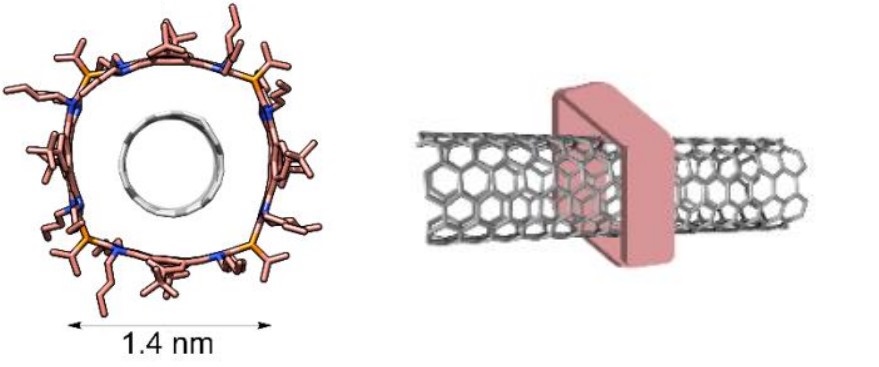Metallacycles embrace carbon nanotubes
20.07.2022
 |
|
Encapsulation of carbon nanotubes within a palladium-based cyclic molecule. Credit: Angewandte Chemie. |
- Researchers thread carbon nanotubes through coordination complexes and open a new field of opportunities for MINTs-mechanically interlocked carbon nanotubes.
- The modification of carbon nanotubes is critical towards new applications.
Madrid, July 20th, 2022. Chemical modification of single-walled carbon nanotubes is a critical step to exploit their properties. Either the covalent modification or the supramolecular functionalization of their surface has resulted in nanotube products with application in, for example, optical sensing and electronics. Other modifications, such as the mechanical interlocking of carbon nanotubes with molecules (MINTs) allows the design of interesting products with similar stability as covalently-modified nanotubes but preserving the native structure of the tubes. Some promising applications of MINTs can be found in reinforcing polymers, metal-free catalysts or qubits.

Now, a group of researchers led by Emilio M. Pérez (Chemistry of Low Dimensional Materials Group at IMDEA Nanociencia) and Eduardo Peris (INAM at Universitat Jaume I) has gone an important step further in the synthesis of MINTs by making them with a supramolecular coordination complex. A supramolecular coordination complex is a chemical product with organic ligands bonded to metal atoms by coordinative bonds. In comparison with MINTs built with purely organic assemblies, coordination complexes may introduce a new dimension in the resulting MINT due to the presence of a metal. The metallic centre can enhance the photoelectrochemical properties of MINTs and can help expand their applications. Also, metal-ligand interactions are one of the most powerful means of building mechanically interlocked molecules.
To attempt the preparation of coordination-complex MINTs, the researchers chose a collection of molecular building blocks that would lead to metallo macrocycles. They found the formation of MINTs with palladium-based metallacycles was very sensitive to the size complementarity between the cavity of the macrocycle and the diameter of the carbon nanotube. But, when the fit is right, the reactions conveyed successfully via “clipping” and “threading” strategies to the same product. That means that this metallo-MINTs can be made either by the formation by self-assembly of metallacycles around the surface of the carbon nanotube (“clipping”) or by encapsulating the carbon nanotube into the cavity of the pre-formed metallacycle (“threading”).
The results exemplify how the directional control of coordination geometries can be used for the preparation of self-assembled structures beyond molecular level. “We think that our work opens a new field for opportunities for MINTs” Prof. Pérez says.
This work is a collaboration between researchers at Institute of Advanced Materials at Universitat Jaume I, Complutense University of Madrid and the Madrid Institute for Advanced Studies in Nanoscience, and has been cofunded by the Severo Ochoa Centre of Excellence Award to IMDEA Nanociencia. The publication has been dedicated to Sir J. Fraser Stoddart on the occasion of his 80 birthday. The publication has been included in the collection “Hot topic: Carbon, Graphite and Graphene” by Angewandte Chemie editors for their importance in a rapidly evolving field of high current interest.
Referencia:
Alejandro López-Moreno, Susana Ibáñez, Sara Moreno-Da Silva, Luisa Ruiz-González, Natalia Martín Sabanés, Eduardo Peris, and Emilio M. Pérez. Single-Walled Carbon Nanotubes Encapsulated within Metallacycles. Angew. Chem. Int. Ed. 2022.
Contact
Prof. Emilio M. Pérez
emilio.perez [at]imdea.org
http://nanociencia.imdea.org/chemistry-of-low-dimensional-materials/home
Twitter: @emiliomperezlab
Prof. Eduardo Peris
eperis [at]uji.es
https://www.uji.es/serveis/ocit/base/grupsinvestigacio/detall?codi=138
Twitter: @Peris_qomcat
IMDEA Nanociencia Dissemination and Communication Office
divulgacion.nanociencia [at]imdea.org
Twitter: @imdea_nano
Facebook: @imdeananociencia
Instagram: @imdeananociencia
Source: IMDEA Nanociencia




